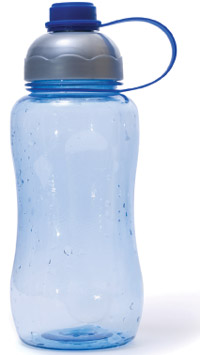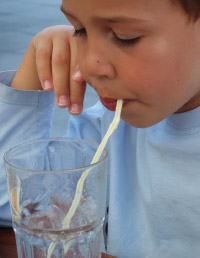Do you drink enough water?
by Cynthia Lair
This article was originally published in August 2010

If a person is told to “move your big toe” and then moves his big toe, the accomplishment of this tiny task is made possible by a series of nerve impulses that travel through the brain, down the spinal cord to the toe. The smooth functioning of the electrical transmissions of our nervous system is highly dependent on water.
Water is important to many bodily functions, such as regulating temperature, transporting nutrients and oxygen to the blood, removing waste, and lubricating joints. Every day our bodies lose water through sweating, exhaling, urination and bowel movements. This water must be replaced. Dehydration can be serious.
For athletes, young or old, if the body is not well-hydrated, exercising ability may be comprised by the body’s need to regulate temperature. The body steals water from inside the cells to cool itself, which limits muscle function. Allowed to continue, the athlete suffers symptoms of heat exhaustion (dizziness, nausea, profuse sweating) or heatstroke (hot, dry skin, headaches, rapid pulse, faintness, flushing) and/or muscle cramps.
The second most common sports injury among young athletes is heat exhaustion or heat stroke, usually complicated by dehydration.
A Tufts University study provides insight into the effects of mild dehydration on young athletes and people who don’t consume enough water daily. Researchers found that dehydration was associated with negative mood, including fatigue and confusion, compared to a hydrated group.
The level of mild dehydration (one to two percent fluid losses) experienced was comparable to what some people experience in daily life from drinking insufficient water. Not surprising.
Our nervous systems need water to function. Our brains are about 90 percent water. Hydration is key not only for physical activity, but for thinking and learning as well.
Surprisingly, thirst is not a reliable indicator of the need for hydration. The human thirst mechanism doesn’t kick in until the body has lost a significant amount of fluid. At this point decreased performance already is evident.
So, by the time you feel thirsty, you already are dehydrated. Adults over 50 have a continually diminished thirst sensation, which can cause chronic dehydration.
Drinking water according to a schedule or a routine is the best insurance. Keep water in your car and at your desk and remember to encourage children to drink water before, during and after play.
Flavored water

Some studies show that flavoring in a beverage enhances thirst and increases voluntary hydration. Liquid with a slightly sweet or citrus flavor works best. A small dose of carbohydrates from the sweetener can give the body a little lift. This is one reason sports drinks can be effective in rehydrating and re-energizing.
Bottled waters such as Metromint, ActiVwater and Twist (available at PCC) have a hint of flavor and varying amounts of calories (45 at most) from added sweeteners. Coconut water is popular and offers a few calories, a healthy dose of potassium, fresh flavor and water. PCC also carries Recharge, a sports drink that combines fruit juice, water and sodium in a variety of flavors.
Homemade sports drinks are a good option and easy to make. The players on my daughter’s soccer team swore by my Lime Boost. Combine a pint of lime juice and a cup and a half of sugar over low heat until the sugar dissolves (Lime Boost recipe on Cookus Interruptus).
Store this simple syrup in a jar in your refrigerator. Fill a water bottle with a few tablespoons of Lime Boost and the rest with water (or add ice and sparkling water for a party beverage). Add a pinch of salt if sodium loss is a concern. Pomegranate juice or lemon juice can be substituted for lime. Or mix them!
Carbonated drinks are not appropriate when playing sports or working out. Carbonation changes the pH levels in the stomach and can produce belching and gas.
Also avoid caffeine and high fructose corn syrup (HFCS) when trying to rehydrate. Caffeinated beverages act as a diuretic and the calories in HFCS don’t readily convert into muscle energy. Sodas that contain HFCS are liquid candy that won’t satisfy thirst but do pile on empty calories.
So next time you exercise in the heat or take a test, make sure to keep your water bottle handy. Sipping often — not gulping — keeps cells functioning at their peak.
Cynthia Lair is author of “Feeding the Whole Family,” host of cookusinterruptus.com and faculty member at Bastyr University. She is curriculum director of Bastyr’s new culinary arts degree program.
